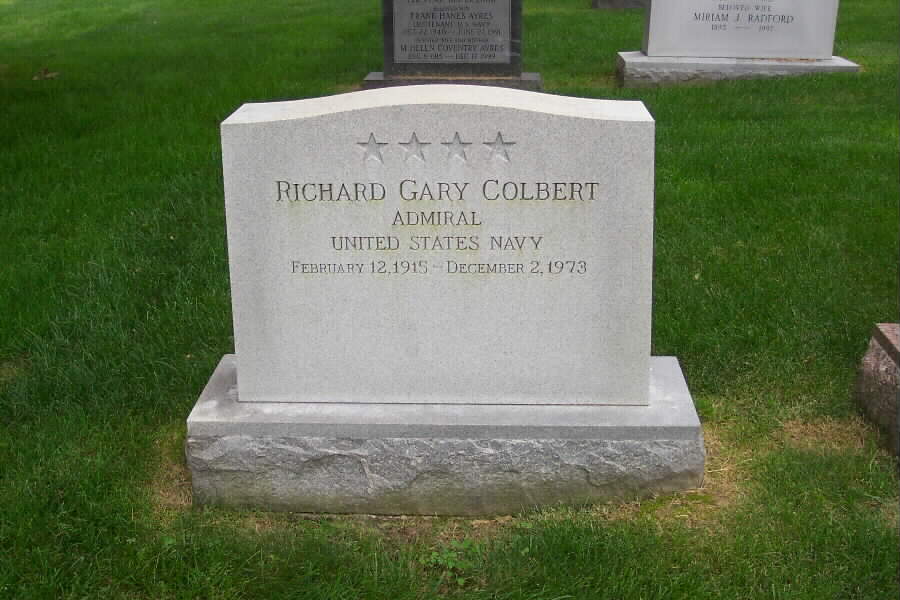Richard G. Colbert was born in Brownsville, Pennsylvania, February 12, 1915, the son of Charles F. Colbert, Jr., and Mary Louise Benford Colbert. Colbert spent his formative years in Pittsburgh where his father was a prominent corporate executive in the coal, coke, and alloy business. He graduated from Shadyside Academy in 1933 and entered the United States Naval Academy as a member of the class of 1937.
After graduation from the Academy, Colbert served a two-year tour in USS YORKTOWN (CV-5), Flagship of Carrier Division Two, Aircraft Battle Force. In 1939, he joined USS BARKER (DD-213) in the Asiatic Fleet and in 1942 became her commanding officer when she joined the Atlantic Fleet for operations in the North Atlantic and Mediterranean.
In September 1944, Colbert took command of the destroyer MEADE (DD-602) in the Pacific Fleet and served in that capacity until the end of World War II. Promoted to commander, he joined the Bureau of Naval Personnel as planning officer. In 1948, he was aide and flag secretary to Admiral Richard L. Conolly, Commander in Chief, U.S. Naval Forces Eastern Atlantic and Mediterranean, in London, England. While serving in this capacity, he met his future bride, Prudence Anne Robertson, daughter of E.J. Robertson, Chairman of London Express Newspaper, Ltd., later Lord Beaverbrook’s Newspapers, Ltd. They were married at St. Paul’s Cathedral, Knightsbridge, in November 1950.
Colbert next served in the Political-Military Affairs Division of the Chief of Naval Operations. He was a Special Assistant to Admiral Forrest Sherman, Chief of Naval Operations, and accompanied him on a visit to Spain to negotiate for United States bases. He was with Admiral Sherman when he died in Naples, Italy, in August 1951. Following his tour in Washington in 1953, Commander Colbert became executive officer of the cruiser USS ALBANY (CA-123), flagship of COMBATCRULANT. Two years later he was ordered to the Naval War College in Newport, Rhode Island, and while there was promoted to Captain. His assignment at the Naval War College developed into a long association. Upon completion of his studies, he was selected by Admiral Arleigh A. Burke to organize the Naval Command College, a resident course for senior naval officers from allied nations, and he served as its first director. Students from thirty nations attended the first course in 1956–1957. Many lifelong friendships resulted from the contacts Colbert made at the Naval Command College.
In 1958, Colbert was assigned to the staff of the Joint Chiefs of Staff in Washington, DC, and was involved in long-range strategic planning in the plans and policy directorate. He returned to sea in June 1960 as commanding officer of the cargo ship USS ALTAIR (AKS-32) based in Barcelona, Spain. During this period, ALTAIR pioneered the concept of vertical replenishment in the Navy. From October 1961 to February 1963, he commanded the missile cruiser BOSTON (CAG-1) operating in the Mediterranean. Early in 1962 Colbert returned to Washington, DC, for an assignment in the State Department as a member of the Policy Planning Council. Promoted to rear admiral, he assumed command of Cruiser Destroyer Flotilla Six in June 1965. A year later he reported to Norfolk, Virginia, as Deputy Chief of Staff and Assistant for Policy, Plans, and Operations to the Supreme Allied Commander, Atlantic.
On August 30, 1968, with the rank of Vice Admiral, Colbert became President of the Naval War College. During his three years at the College, he implemented several long-range programs which were continued by his successors. Keenly interested in the future development of the Navy’s senior educational institution, he inaugurated a program for the construction of three academic buildings over a period of several years. He proposed an increase in student enrollment, and he made changes in the curriculum. He encouraged the study of internal United States affairs through lectures and seminars devoted to social and political movements, strengthened elements of the military education program, and emphasized student research and writing in matters dealing with national security.
During Colbert’s tenure, the first International Seapower Symposium was held at the College in 1969. The Symposium was envisioned as an open forum where leaders of free world navies would discuss the implications of rapidly changing maritime situations. In November 1969, the Naval War College Foundation was established as a result of Admiral Colbert’s personal interest and initiative. A private non-profit corporation, it provides resources to the Naval War College to help accomplish its educational mission.
In June 1971, Colbert was ordered to duty as Chief of Staff to the Supreme Allied Commander, Atlantic, with headquarters in Norfolk, Virginia. The next year he was appointed Commander in Chief, Allied Forces Southern Europe, with the rank of Admiral. Ill health forced him to retire on November 25, 1973, and on December 2, 1973, he died at Bethesda Naval Medical Center. He was buried with full military honors in Section 30 of Alrington National Cemetery.
Admiral Colbert received two Distinguished Service Medals, the Legion of Merit, and a Joint Service Commendation Medal. In 1970, Salve Regina College in Newport, Rhode Island, awarded him an Honorary Doctor of Education Degree. On June 24, 1974, the plaza adjacent to the three new academic buildings at the Naval War College was dedicated in his honor. In that same year, a Richard G. Colbert Memorial Prize was established to be awarded annually to the author of the best Naval War College student essay.
Michael Robert Patterson was born in Arlington and is the son of a former officer of the US Army. So it was no wonder that sooner or later his interests drew him to American history and especially to American military history. Many of his articles can be found on renowned portals like the New York Times, Washingtonpost or Wikipedia.
Reviewed by: Michael Howard

